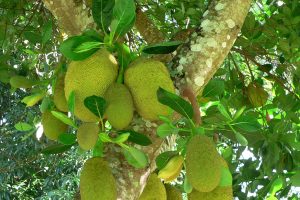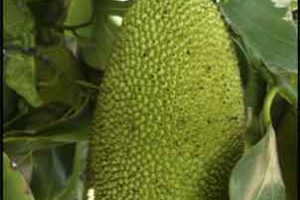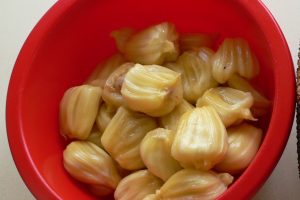Artocarpus heterophyllus
Jakfruit, jak
Origin
Native to southern Asia, and now pantropical.
Climate
It grows best in warm and humid frost-free climates with mean temperatures of 25-30°C, elevations less than 1500m and within 25 degrees of the Equator. Evenly distributed precipitation of >1500mm pa is optimal. It is not cold, drought or flood tolerant.
Plant Description
Jackfruit is a fairly fast growing, laticiferous, monoecious, evergreen tree up to 15m tall with a dense dome-shaped canopy. It has a long taproot. The glossy dark green elliptic or oval leaves are alternate and spiral on horizontal and ascending branches respectively, 4-20cm long by 2-10cm wide. They are often lobed on juvenile plants (heteroblasty).
Relatives
Moraceae Family. Relatives include fig, mulberry, chempedak, marang, breadfruit, kwai muk, lakoocha and pedalai, with about 15 edible species in the genus.
Soils
Well-drained sandy and clay loams are preferred but a wide variety can be used with pH 5.5-7.5.
Propagation
Seed from selected trees has been the traditional method but resulting fruit quality can vary greatly. Cuttings and air layering are possible but the principal vegetative approaches are grafting and budding. The copious latex means a double cut of the rootstock has to be made; after the first cut and when the latex stops flowing, a second cut is then made lower down for the actual graft. Seedlings are usually grown on for 12 months in shade before being used. They can be self-grafted (on seedling Jakfruit rootstocks).
Cultivars
There are two types of fruit – soft and crisp. Some available in Australia are: soft: Black Gold, Cheena (a jackfruit/ chempedak hybrid) and Golden Nugget; and for the crisp: Cochin, Lemon Gold and Honey Gold.
Flowering and Pollination
Flowers are cauliflorous. The single sub-sessile staminate flowers, 5-12cm long and 2-4cm wide, on new wood are green with a smooth skin when young and become yellowish and rough when mature. The solitary or paired, round or elliptical, drooping pistillate flowers, 5-12cm X 8-9cm, on old wood have a thick peduncle and light to dark green skin. There is some evidence of self-incompatibility. Insects are attracted to the sticky sweet yellow pollen but pollination is mainly by wind.
Cultivation
Full sun is preferred but it will tolerate some shading. Although in tropical climates it is often advised to plant out seedlings in the first year, it may be preferable to delay this for another year in Perth conditions. Twice yearly applications of NPK plus Mg should be applied, with amounts increasing according to tree size. Regular trace elements will also be necessary in poor soils. Mulch is beneficial.
Wind Tolerance
They have moderate wind tolerance, however fare poorly with drying winds.
Pruning
Tip pruning will encourage branching when young, and size containment and removal of any dead wood may be necessary when mature. Trees should be kept to 2.5-4m tall for ease of harvesting.
The Fruit
The pear or barrel-shaped fruit are syncarps and can weigh up to 40kg. Fruit are pale or dark green when young and turn greenish yellow, yellow or brownish when mature. The 1cm thick rind with multiple short spines, the central receptacle, and (usually) the strap –like perianths/unfertilised flowers between arils (rags) are not eaten. It’s the arils and the brown seed inside each that are the main edible components; the seeds first need to be cooked, usually by roasting. The arils and seeds make up about 40% of fruit weight and there may be hundreds of them in a good sized fruit. The soft type fruits have a strong odour, whereas in the crisp types, it is less so. Jakfruit have good levels of Ca, Fe and vitamin C, with 25% carbohydrates.
Fruit Production and Harvesting
Seedling-grown trees may take 3-14 years to bear. Up to one third of fruit may drop in the first 2-3 months and those remaining may take 6 months to mature in cooler climates. Mature trees can produce 20-200 fruit per year, but there is a tendency to alternate bearing and fruit should be thinned to 1 per fruiting shoot. If fruit are left to drop before collecting, this must be done regularly, as storage life is only a few days. However the best time for harvesting is just before drop.
Fruit Uses
Most fruit are eaten fresh, but they can also be dried, frozen, used in ice creams, jams etc, or cooked as a vegetable when unripe. The copious latex often makes fruit preparation difficult; smearing oil on all surfaces coming in contact with the fruit eases the problem. Seeds should be boiled or roasted.
Pests and Diseases
A variety of problems can occur, including those caused by borers, weevils, mealy bugs, scales, aphids and various rots.
Comments
Jakfruit is outside its preferred range in southern WA but it can be fruited here with care. Some people find the odour objectionable. Another issue is the sheer size of the fruit, so that some form of processing may be necessary to avoid wastage. The better cvs have perianths which are easily removed and also have very little latex, resulting in less messy preparation.



